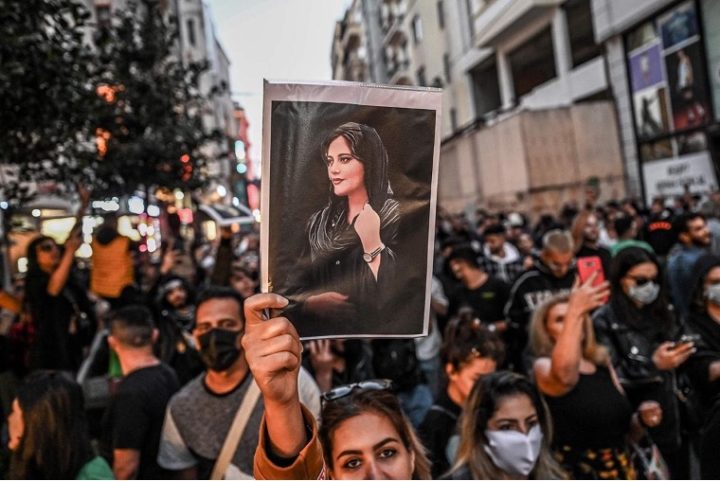
tw: Violence and trauma connected to recent and ongoing conflict in Iran
On 13 September 2022, 22-year-old Mahsa Amini, a native of the Kurdish region in western Iran, was with her brother at a subway station in Tehran when she was stopped by the Iranian government’s morality police. She was accused of not complying with the state’s compulsory hijab laws. Amini’s brother was told she would be taken to a detention centre to receive training on the rules regarding how to properly wear a headscarf. Three days later, on 16 September, Mahsa Amini died. While the government maintains that she had an underlying health condition, her family—and millions of others—believe she was killed.
Amini’s tragic death has ignited mass protests within Iran. In the beginning, these protests were mostly led by women, and focused on ending the strict clerical laws that make it mandatory for women to wear hijabs or headscarves. These protests have since morphed into something much larger; all across Iran, people are coming out to express their grievances with the nation’s regime. Anger has been building against the regime not only for its repressive laws, but also for the economic hardship the country is facing. The nationwide protests have escalated from calling for an end to the law requiring women to wear a hijab—which came into effect in 1983—to protesters demanding to overthrow the entire clerical establishment, which has governed the country since the Iranian Revolution in 1979.
Iranian state TV has reported that at least forty-one protesters and police have been killed since the demonstrations began on 17 September. An Associated Press statement estimates that there have been more than 1,500 demonstrators arrested and, according to advocacy group Iran Human Rights, at least eighty-three people have died in the protests. It is likely that the number of deaths and arrests is underreported, as there have been government-imposed internet blackouts in Iran since the protests began.
It is not just across Iran that you can hear the chant “Woman, life, freedom”; Mahsa’s death has set off an outpouring of support and protests around the world. In Toronto, members of the Iranian Canadian diaspora have been attending protests several times a week since Mahsa’s death. On 1 October, more than fifty-thousand protestors marched in a freedom rally to show solidarity with the people of Iran. Toronto is home to a large Iranian diaspora, many of whom have shared that they feel a sense of helplessness at having to watch the protests and violence against demonstrators from afar.
Recently, there has been brutal repression of protests at schools and universities in Iran. Sharif University of Technology in Tehran was one such school, subjected to attacks by the Islamic Republic. Videos posted to social media show guards trapping students in various parts of campus—including parking lots—and arresting, injuring, or shooting them en masse.
The Iranian regime is no stranger to civil unrest. In January 2020, mass protests occurred in Iran and Canada in response to the shooting down of flight PS752, which killed 176 people, 138 of whom were Iranian and Iranian Canadians travelling to Canada via Ukraine. In November 2019, there were mass protests in Iran due to the economic situation faced by the country. Over 1,500 protesters were reported killed during an internet blackout, and many sources suggest that the death toll was significantly higher. When asked if these most recent protests feel different, Professor Hengameh Saberi—a prominent Canadian Iranian, and a professor at Osgoode Hall Law School—said, “Only time can tell what will happen. The 2019 protests were more of an economic nature; it had less potential to bring people together across various socio-economic segments of the society. This is now a more popular social movement.” Saberi continued by saying, “The fact that half of society right now have joined the other half, men have joined women, is an interesting marker of the resistance, and that is a type of unity that invites more people to join in because they can naturally identify with the underlying struggles.”
Saberi highlights an important point; though the protests started with the death of Mahsa and the repression of women’s rights, it is now about the broader repression of civic rights, and long-term dissatisfaction with economic suffering. After almost three weeks of protests, the demonstrations are far from over, and there is no way of knowing how this situation will end.
On Monday, 10 October 2022, the protests spread to key oil refineries as the country’s oil workers went on strike, with videos posted to Twitter showing workers at Bushehr Petrochemical chanting “Do not fear, do not fear, we are all together!” and “Death to the dictator!” The situation is evolving quickly, and this newfound support could be a turning point in the protests, just as striking oil workers marked a pivotal moment in the revolution of 1979.
Saberi won’t yet draw definitive conclusions, stating, “What I am confident about is that there is no way we go back to pre-Mahsa Amini time.”
“It is difficult to know what the fate of the movement will be, but what I am confident about is that this is another landmark episode, with a cumulative effect for whatever is next, even though no one knows what that’ll be.”
